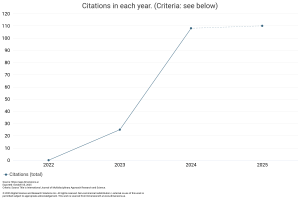Sonny’s Blues: Art, Suffering, Racism, and Redemption through Music in James Baldwin’s Harlem
DOI:
https://doi.org/10.59653/ijmars.v3i03.1888Keywords:
suffering], racism, redemption, music, identityAbstract
This paper critically analyzes James Baldwin’s short story Sonny’s Blues as a socio-cultural narrative of suffering, racial segregation, and the redemptive power of music. Set in Harlem, the story explores how African American identity, familial relationships, and artistic expression intersect in the lives of two brothers. Through the lens of blues and bebop jazz, the research interrogates how Baldwin constructs a symbolic framework of trauma, communication, and salvation. The study highlights the story's religious imagery, racial critique, and musical metaphors to understand Baldwin’s broader commentary on black suffering and resistance.
Downloads
References
Baker, H. A. (1984). Blues, Ideology, and Afro-American Literature: A Vernacular Theory. University of Chicago Press.
Baldwin, J. (2009). “Am I Blue.” YouTube, uploaded by James Baldwin Official, 19 July 2009, www.youtube.com/watch?v=xELxrFgefao.
Baldwin, J. (n.d.). “Bebop Style Sheet.” Jazz in America, www.jazzinamerica.org/jazzresources/set.
Baldwin, J. (1998). “Sonny’s Blues.” Early Novels and Stories, edited by Toni Morrison, Library of America, 635–661.
Baraka, A. (1965). Blues People: Negro Music in White America. Morrow.
Blake, S. L. (1986). Religious Symbolism in James Baldwin’s ‘Sonny’s Blues.’ Journal of African American Literature, 12(1),–115.
Bowen, M. (1978). Family Therapy in Clinical Practice. Jason Aronson.
Campbell, J. (1991). Talking at the Gates: A Life of James Baldwin. University of California Press.
Caruth, C. (1996). Unclaimed Experience: Trauma, Narrative, and History. Johns Hopkins University Press.
Delgado, R., & Stefancic, J. (2017). Critical Race Theory: An Introduction. 3rd ed., NYU Press.
Dempsey, R. (2018). Silence and Communication in Baldwin’s ‘Sonny’s Blues.’ African American Review, 52(1), 70–81.
Giles, P. (2008). Spatial Boundaries and Segregation in Harlem. American Literary History, 20(1), 143–160.
Goldstein, D. (2012). Narrative Structure and Family in ‘Sonny’s Blues.’ Studies in American Fiction, 19(1), 64–75.
Henderson, R. (2010). Blues Epistemology in Baldwin’s Jazz Narratives. Journal of Musicology, 27(2), 117–134.
Jones, J. C. (1999). Finding a Way to Listen: The Emergence of the Hero as an Artist in James Baldwin’s ‘Sonny’s Blues.’ CLA Journal, 42(4), 462–482.
Jones, L. (1998). Blues People: Negro Music in White America. William Morrow.
McClane, K. A (2002). Brotherhood and Trauma in Baldwin’s Work. Critical Perspectives on African American Literature, 5, 91–102.
Nelson, C. (2015). Suffering and Redemption in African American Literature. Journal of African American Studies, 12(1), 25–40.
Nelson, E. S. (2003). African American Literary Theory: A Reader. NYU Press.
Ognibene, R. J. (1979). Sonny as Christ Figure in Baldwin’s ‘Sonny’s Blues.’ Journal of Black Studies, 10(1), 35–43.
O’Meally, R. G. (1982). The Jazz Cadence of American Culture. Columbia University Press.
Poudel, P. (2025). Unintentional Animal Violence in Novel Engel’s Bear and Coetzee’s Disgrace. DS Journal of Language, Linguistics and Literature, 3(1), 9-20. https://doi.org/10.59232/LLL-V3I1P102
Reilly, B. (2001). Art as Testimony: Baldwin’s Transformation of Pain. African American Review, 35, 85–95.
Sherard, S. (1993). Psychological Cost of Racial Oppression in ‘Sonny’s Blues.’ African American Studies Quarterly, 10, 110–120.
Sherma, A. B. (2025). Baldwin’s “Sonny’s Blues”: An Historical Story of Double-Consciousness and Its Relevance in Today’s America. THE ACADEMIA, 5(1), 1–14. https://doi.org/10.3126/ta.v5i1.77111
Sherrod, T. (1998). Sonny’s Bebop: Baldwin’s Blues Text as Intercultural Critique. African American Review, 32(4), 691–749.
Stanley, F. (1980). Music as Epiphany in ‘Sonny’s Blues.’ Journal of American Literature, 52(1), 50–60.
Tyson, L. (2006). Critical Theory Today: A User-Friendly Guide. Routledge.
Wilson, M. (2013). Memory and Healing in Baldwin’s Narrative. Journal of African Diaspora Studies, 4(2), 80–89.
Downloads
Published
How to Cite
Issue
Section
Categories
License
Copyright (c) 2025 Bhoj Raj Adhikari

This work is licensed under a Creative Commons Attribution-ShareAlike 4.0 International License.
Authors who publish with this journal agree to the following terms:
- Authors retain copyright and grant the journal right of first publication with the work simultaneously licensed under a Creative Commons Attribution-ShareAlike that allows others to share the work with an acknowledgement of the work's authorship and initial publication in this journal.
- Authors are able to enter into separate, additional contractual arrangements for the non-exclusive distribution of the journal's published version of the work (e.g., post it to an institutional repository or publish it in a book), with an acknowledgement of its initial publication in this journal.
- Authors are permitted and encouraged to post their work online (e.g., in institutional repositories or on their website) prior to and during the submission process, as it can lead to productive exchanges, as well as earlier and greater citation of published work (See The Effect of Open Access).
























